Whether you call it Dressing or Stuffing, it's the traditional mainstay of every holiday meal, outshining all the other side dishes. This traditional South Louisiana Dressing is an oyster dressing with pork sausage and giblets. Add the distinct flavor of Sage and you have Sweet Daddy D’s New Orleans Oyster Dressing.
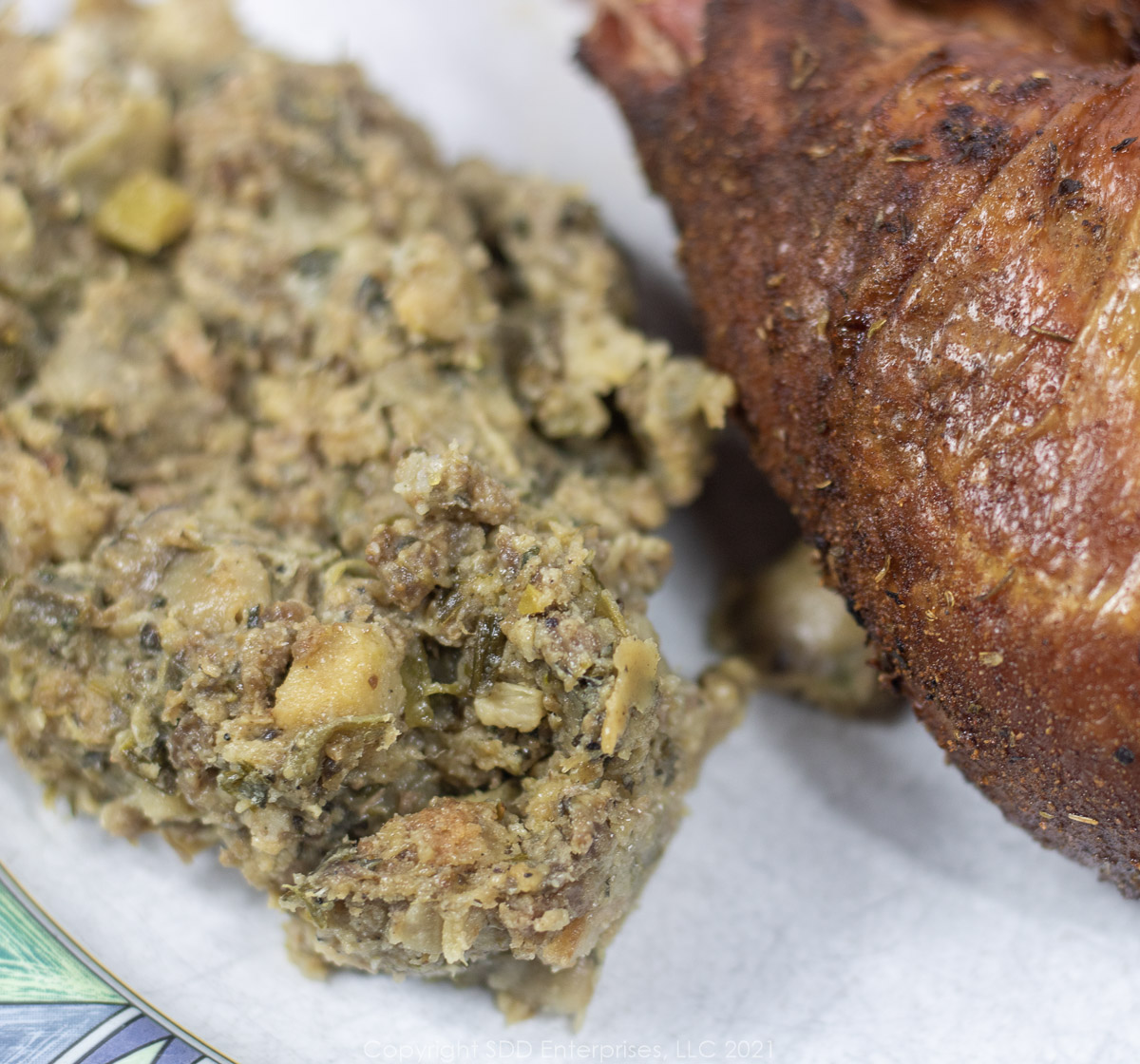
This post is not sponsored, but you will find affiliate links on this page. As an Amazon Associate, I earn from qualifying purchases. The price you pay as a consumer does not change, but I may make a small commission based on your purchase.
If you want to just skip to the recipe, click the "Jump To Recipe" button above or the Recipe link below and you’ll go right there without having to scroll through my article.
Jump to:
Holiday Tradition in South Louisiana
In South Louisiana, we call it Dressing and it comes in as many varieties as Gumbo. Everyone has their favorite which makes it special. Although the origins of stuffing or dressing can be traced back to the early Roman days, similar dishes appear in all areas of the world. It's no mystery that stuffings/dressings are traditional dishes reflecting traditional processes and customs. Migrants to Louisiana in the 18th and 19th Centuries surely adapted fresh local ingredients to traditional recipes. Oysters and other seafood, pork, beef, and a huge variety of vegetables native and adaptable to South Louisiana became the framework for Cajun and Creole traditional recipes. During the early decades of Colonial Louisiana, Creole cooks had a wide variety of fresh ingredients provided by numerous truck farms and a thriving Port. Cajun cooks relied on the land and waterways to provide a bounty of available ingredients to their culinary tradition.
This New Orleans Oyster Dressing is more of a Creole-style recipe as opposed to Cajun, but the line between the two can be very thin. The roots of this recipe are in the family kitchen of my youth. My father would make his dressing the night before Thanksgiving every year. I can still see him chopping the onions and still smell that comfortable aroma of onions, oysters, and sage cooking in butter. Although I never saw a written recipe (I doubt he had one), I pattern my recipe from what I saw him do year after year. The tradition continues...I even use the same frying pan that he did!

Here’s What You Need
There are a lot of flavor drivers in this recipe. These grouped ingredients are for the Dressing but note that there are a few separate ingredients for the stock listed at the end. The stock is optional, so you may choose to skip those.
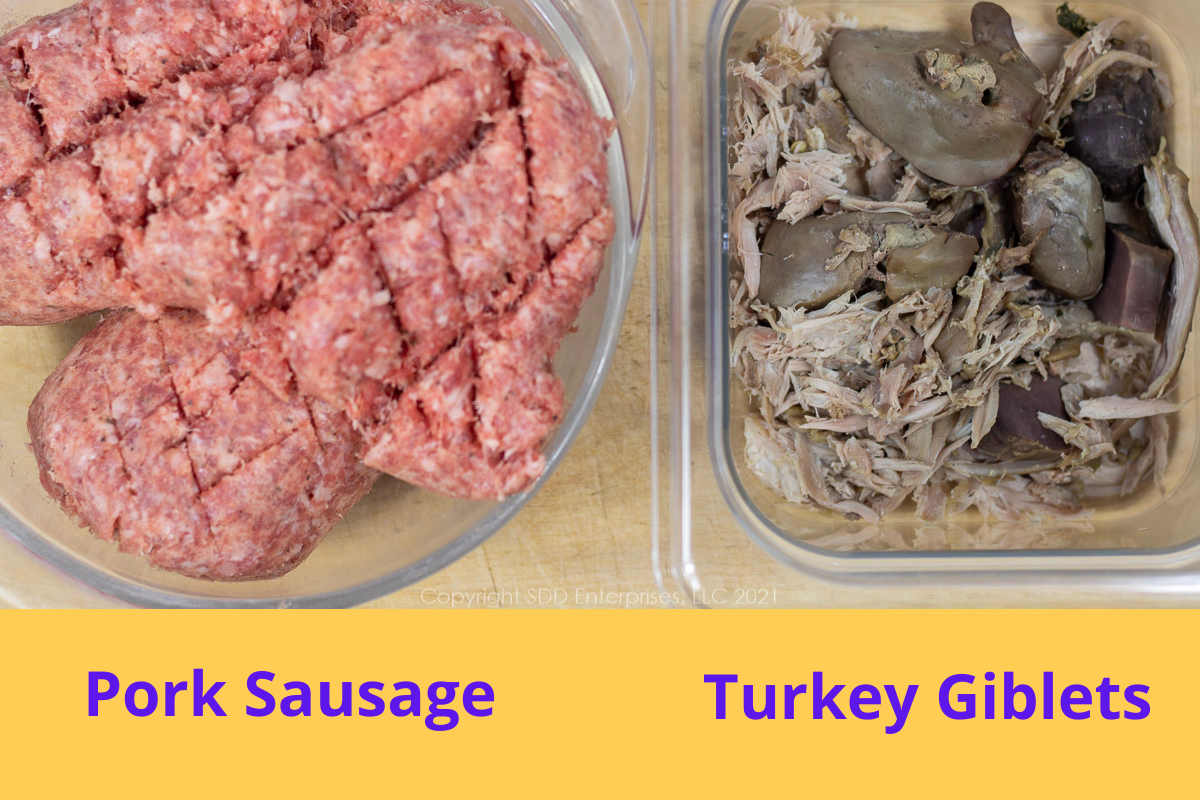
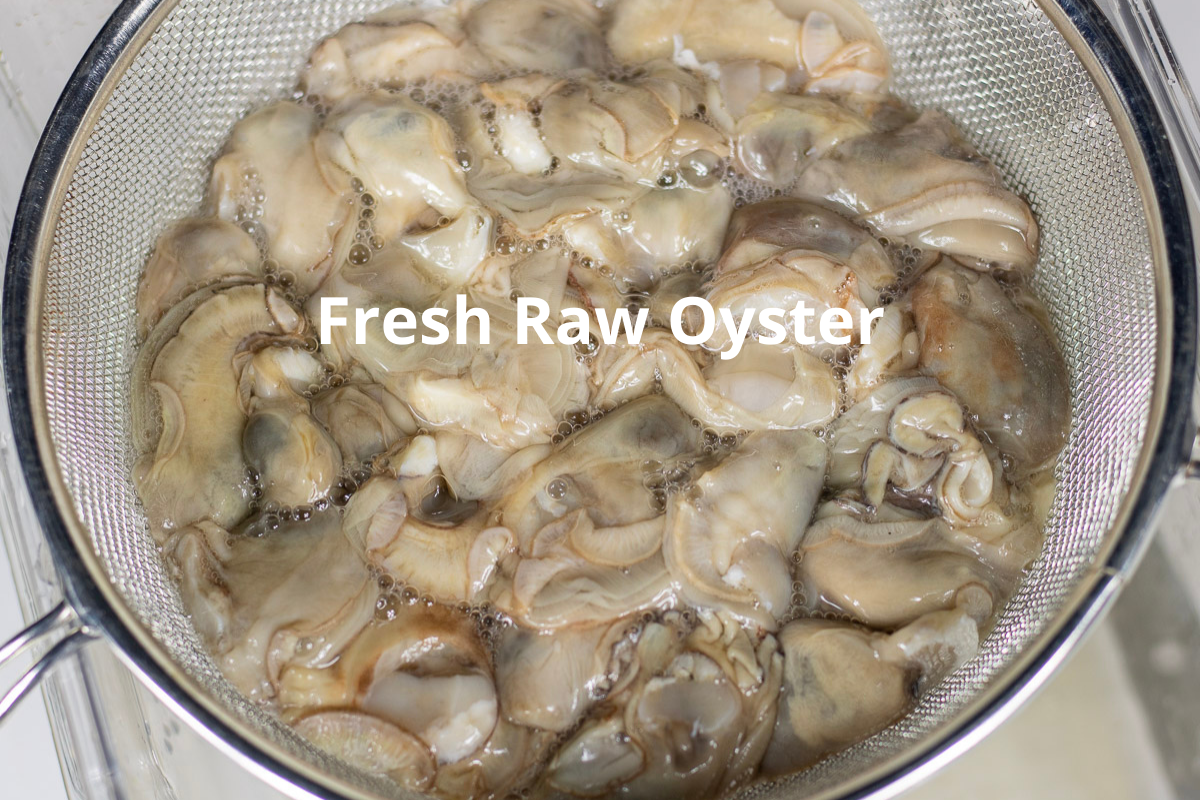

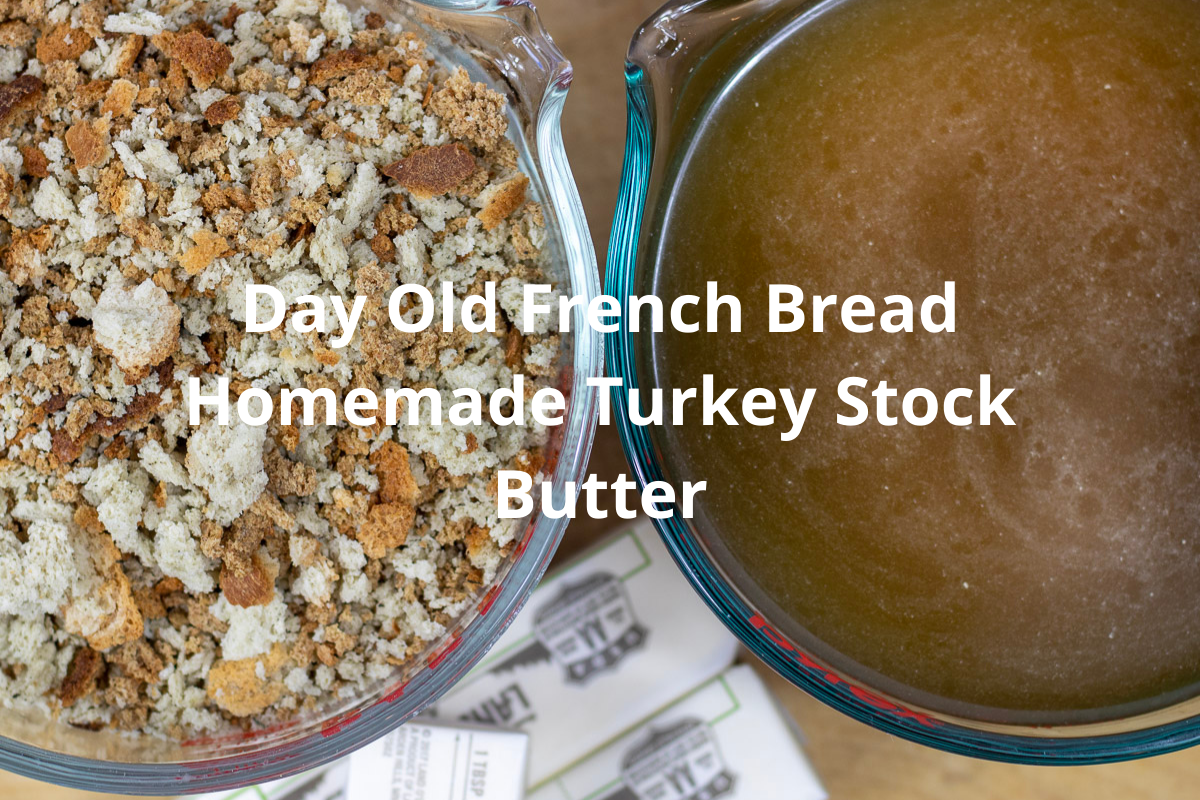
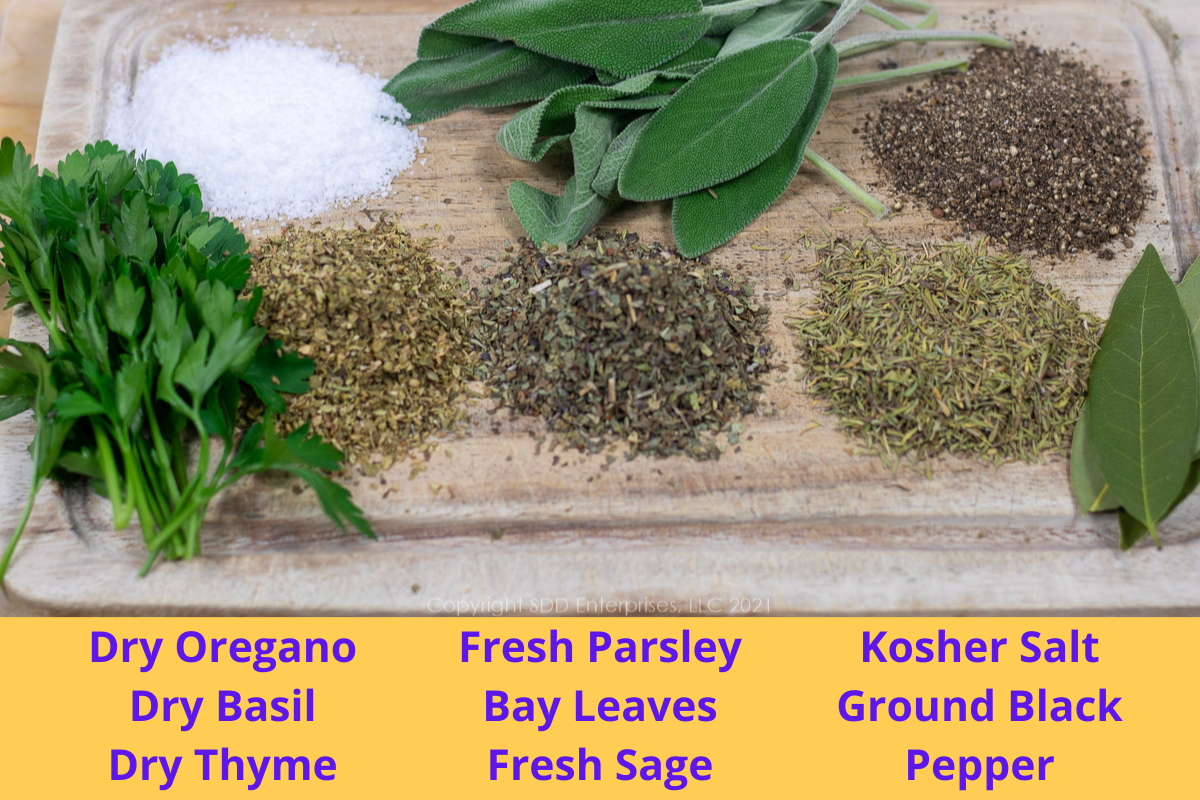
Giblets are the gizzard, liver, heart, and neck of poultry, generally used for flavoring recipes. Although there are substitutes for homemade stock, in this recipe we use it to prepare the Giblets which is central to the flavor profile.
These are what you need to prepare the giblets, including a few optional ingredients.
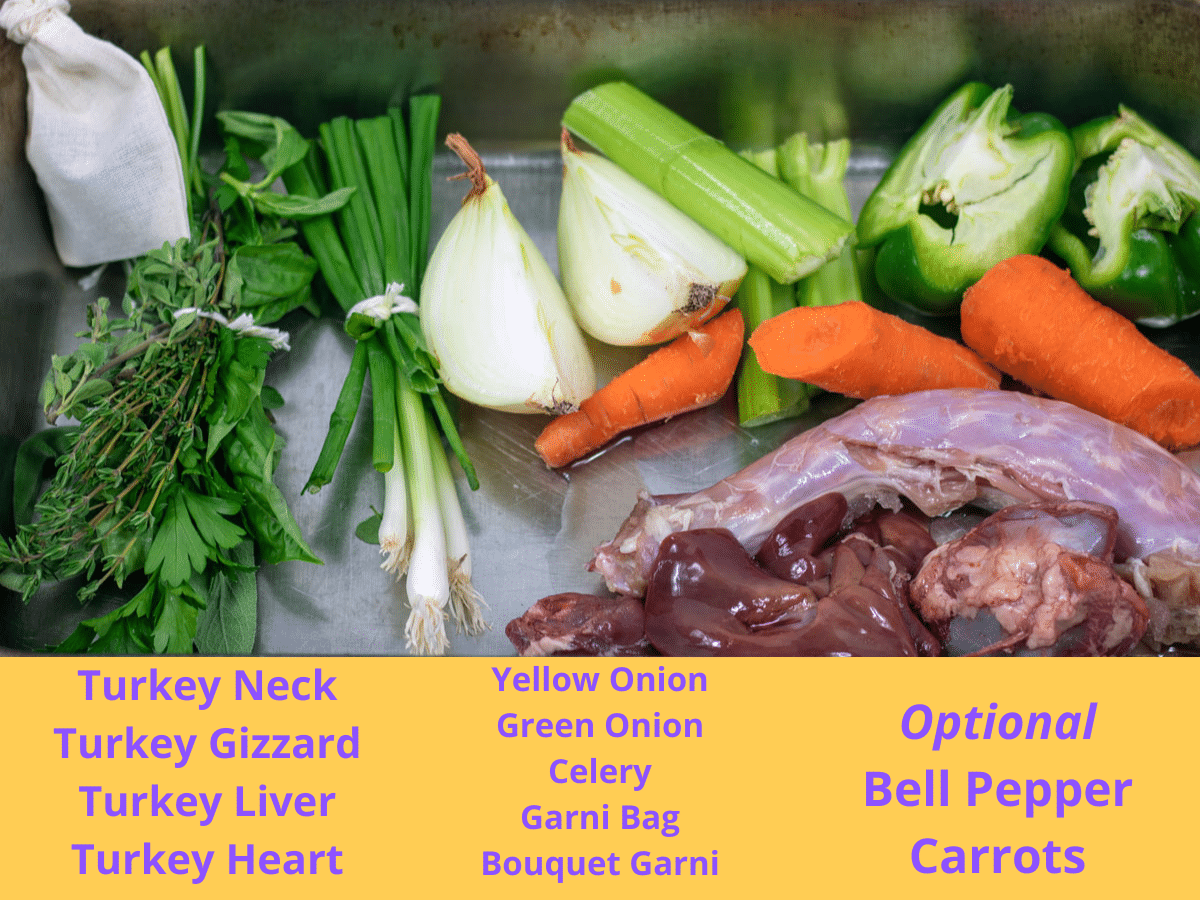
Notes on the ingredients:
- The giblets from your turkey play a key role in this recipe. Remove the pouch with the livers, gizzards, and heart from the turkey’s neck cavity. If there is no giblets pack available, buy a turkey neck, turkey (or chicken) liver and gizzards. A bone-in skin-on turkey or chicken thigh can be used in place of the neck.
- Since you have to cook the giblets anyway, you just as well make the stock when you do. But, if you’d prefer to skip that step, just substitute some commercial turkey or chicken stock. Read how to do that in the Prepare the Giblets section below.
- Use bulk pork sausage. I have always used Jimmy Dean Pure Pork Sausage, but you can use your favorite if you have one. I stay away from flavored (maple, sage, whatever) because I like to control the amount of spice and seasoning.
- For the bread stuffing, it's basically stale french bread. You can make your own out of stale french bread but make sure to cut it up small pieces, not as fine as bread crumbs. Pepperidge Farm Herb Seasoned Stuffing works fine. If you can find it unseasoned that’s even better. Insider tip-2 boxes of Stove Top Stuffing Mix provide the 4 cups of stuffing bread this recipe calls for and it comes in pork, chicken or turkey flavors. I’ve used it many times.
- About the vegetables: You’ll need about 10 cups of onions and celery in all. Dice about 5 or 6 yellow onions and about 6 or 7 bunches of green onions-use both the green and white parts. Use at least 6 toes of garlic, chopped fine; about 5 stalks of celery, chopped (but too much makes things a little bitter) and about half a cup of parsley. Set some of the garlic and parsley aside to use with the oysters, according to the recipe. I don’t use green peppers in the dressing, but if you make the stock, a piece of bell pepper is always an option.
- Use fresh oysters. The number of oysters in a pint will vary depending upon the size of the oysters, ranging from as few as 15 to 20 to as many as 50, but 2 pints will be 4 full cups of oysters and their delicious, briny juice. Freshly shucked oysters are the best!
- Sage provides a distinctive flavor that is a key ingredient to this recipe. Use fresh sage (even though the other herbs are dried). If you don’t like sage you can leave it out, but I’d increase the number of dried herbs you use.
Equipment
You’ll need a large frying pan and a couple of 9” X 13” baking dishes, or other similar baking dishes, a stockpot, and a small food processor or chopper to prepare the giblets and a saute pan for the oysters.
This post is not sponsored, but you will find affiliate links on this page. As an Amazon Associate, I earn from qualifying purchases. The price you pay as a consumer does not change, but I may make a small commission based on your purchase.
These items will help in making this recipe:
Stock Pot, Dutch Oven, Frying Pan, Baking Dish, Chef’s Knife, Cutting Board, Prep Bowls (Cambro), Prep Bowls (Glass), Measuring Cups-Glass, Measuring Cups-Metal, Measuring Spoons, Small Food Processor, Large Food Processors, Kitchen Strainer, Garni Bags
Here’s What You Do
First...you have a beer. One of the great things about traditions like this is that family and friends participate in the preparation of the meal. Besides needing more beer, you can enlist people to help chop and measure. Mise en place starts with a beer. While you drink it, read the recipe from top to bottom and make sure you have all the ingredients and you know what to do with them.
Mise en place
Here are the basic preparation steps:
- Deal with the giblets first. They can be prepared the day before and kept in the fridge, we’ll cover that in the Prepare the Giblets section next.
- Note that some of the butter, garlic and parsley will be used when preparing the oysters, so those ingredients will be divided.
- Chop and measure all the ingredients-put the yellow, green onions and celery in the same bowl. Put the garlic, sage, parsley and the Herb and Spice Blend, each in their own separate bowls.
- Strain the oysters, but keep them and their juice in the fridge until you need them. You’ll finely chop about ⅓ of the oysters just before you add them.
- Set out the pork sausage, stock, butter, bread stuffing and stock.
Prepare the Giblets
What happens in this step? The giblets provide an earthy, natural element to the flavor profile. This step prepares the giblets to be used in the recipe while also making some delicious turkey stock that we will use.
Place the turkey neck, liver, gizzard and heart in a stockpot. If you want to make the stock from scratch, add a chunk of celery, a small yellow onion quartered, a few toes of garlic chopped in half, a chunk of bell pepper, about 5 green onions. Place some peppercorns and broken bay leaves in a garni-bag. Make a Bouquet garni with parsley, fresh sage leaves, thyme, oregano, basil in twine.
Add about 1 tablespoon of vegetable oil to the stockpot over medium-high heat. Place the onions and garlic cut side down in the hot oil and brown for about 5 minutes. Add all the remaining ingredients then cover everything with about 8 cups of cold water.
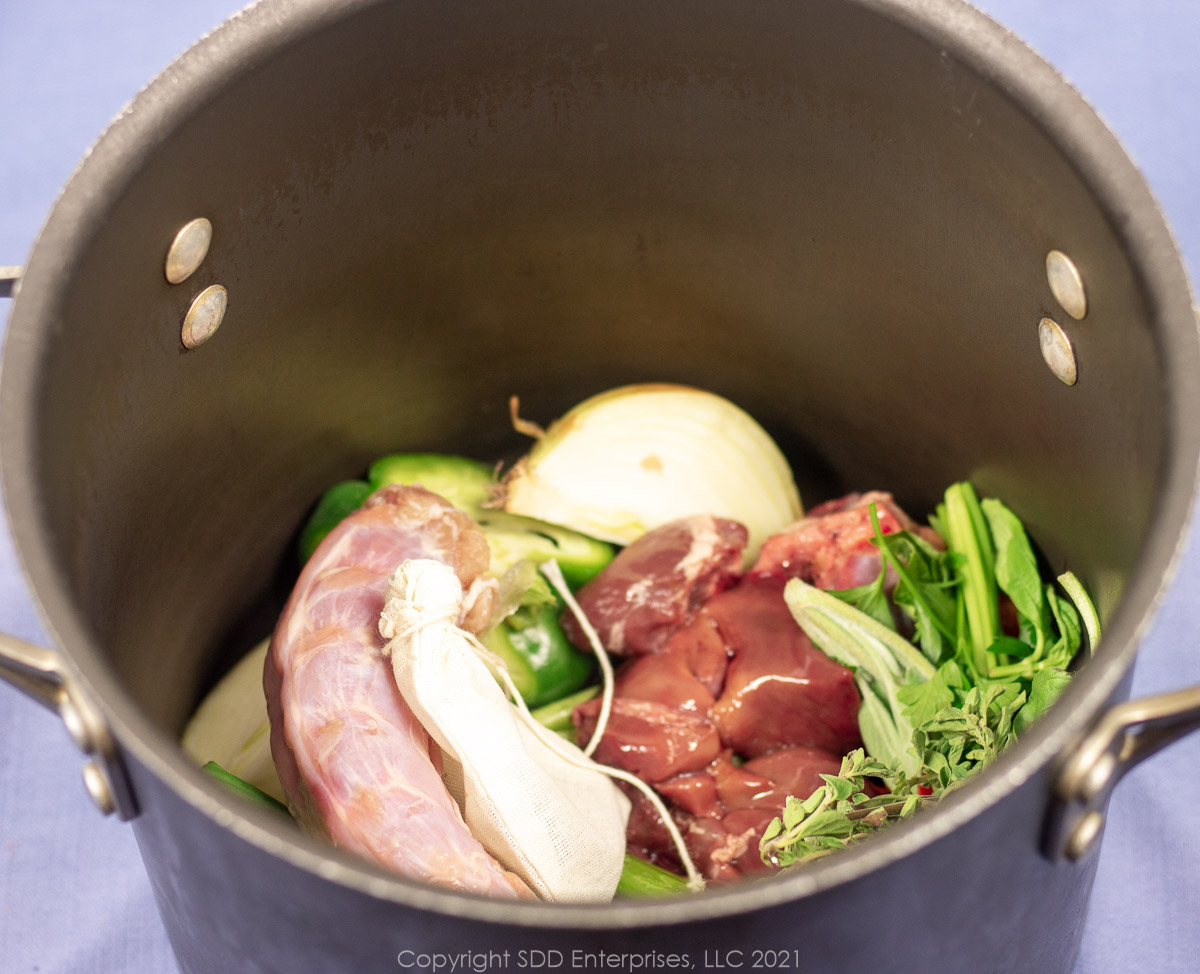
Bring this to a boil before lowering the heat to a slight simmer. After about 15 minutes you will see some impurities accumulating on top. Skim these off and discard them. Continue a very low simmer until the liquid reduces by about half, which should take about an hour to an hour and a half. After an hour, remove the liver, gizzard and heart and set aside to cool. After an hour and a half, remove the neck, and any other poultry meat you have used. Strain the stock into a measuring cup and discard the cooked veggies. It can be completed up to this point the day before, or do the next step and then put it in the fridge.
Tip: A simple substitute for making the stock is adding about 6 to 8 cups of commercial stock to the giblets and simmering for an hour. Remove the giblets and strain the stock for use in this recipe.
Once the giblets are cooled, slice off any cartilage attached to the gizzards. Pull as much meat as possible off the turkey neck with your fingers and a fork. Place all of this in a small food processor, add a little stock (maybe ⅛ of a cup), and process until a paste forms. Set this aside in a small bowl. It should be about 1 cup. All of this can be done the day before and kept in the fridge.
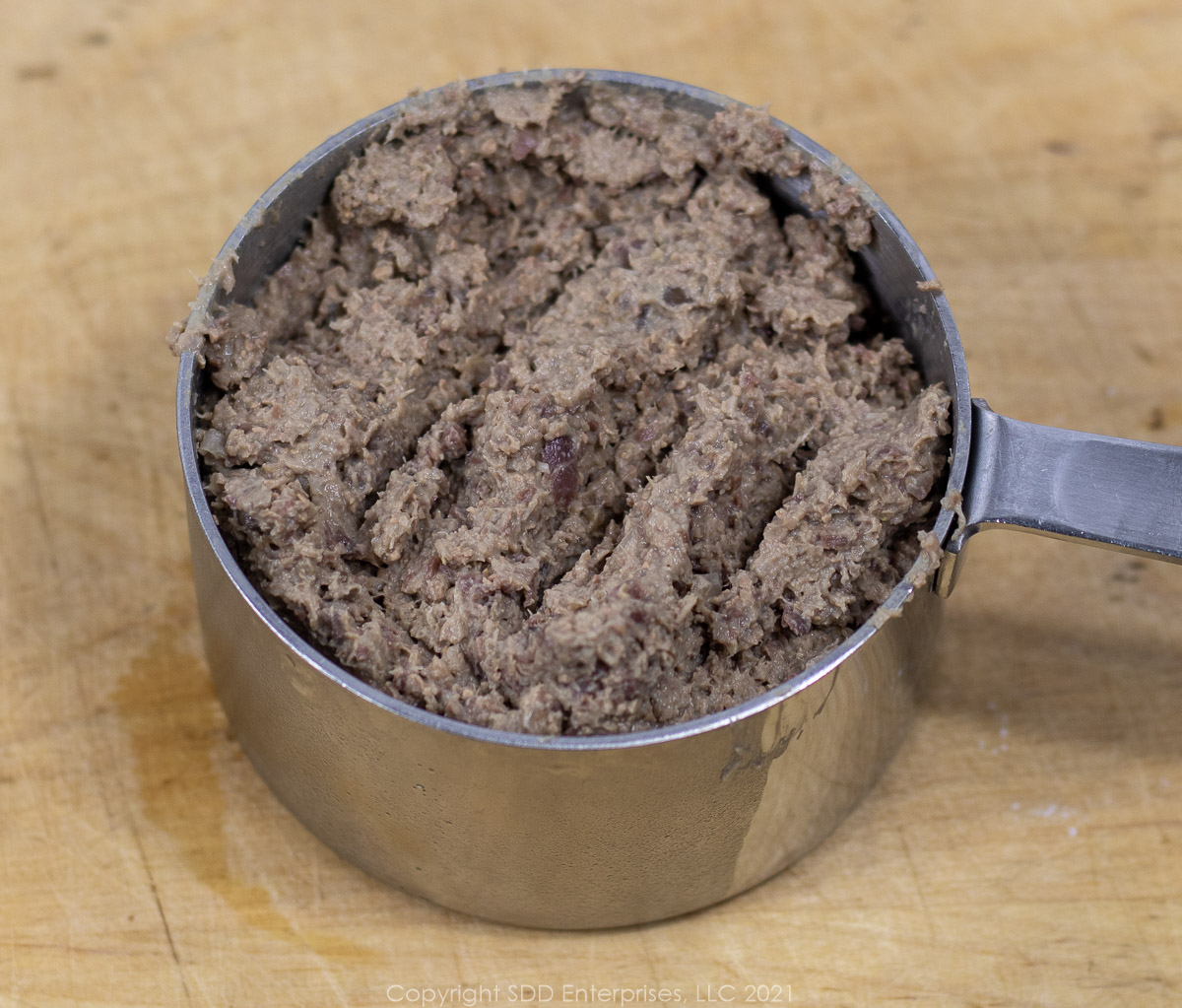
Now you have your giblets set aside, your spices set aside and your veggies chopped. If you haven’t figured it out already, this is a good time to have another beer. Let's get going.
Prepare the dressing
Start with the sausage
What happens in this step? As you know we want to construct the flavor of this recipe in layers. The first layer starts by browning the fresh sausage leaving some rendered fat and fond in the pan to lend flavor to the subsequent layers.
In a large skillet, brown the pork sausage over medium-high heat. This will take about 5 minutes. Remove the browned sausage from the pan but leave the rendered fat and fond. There should only be 2 or 3 tablespoons of fat but if it looks like too much grease (like more than ½ cup) remove some. Don't stress over this, you want that flavor!
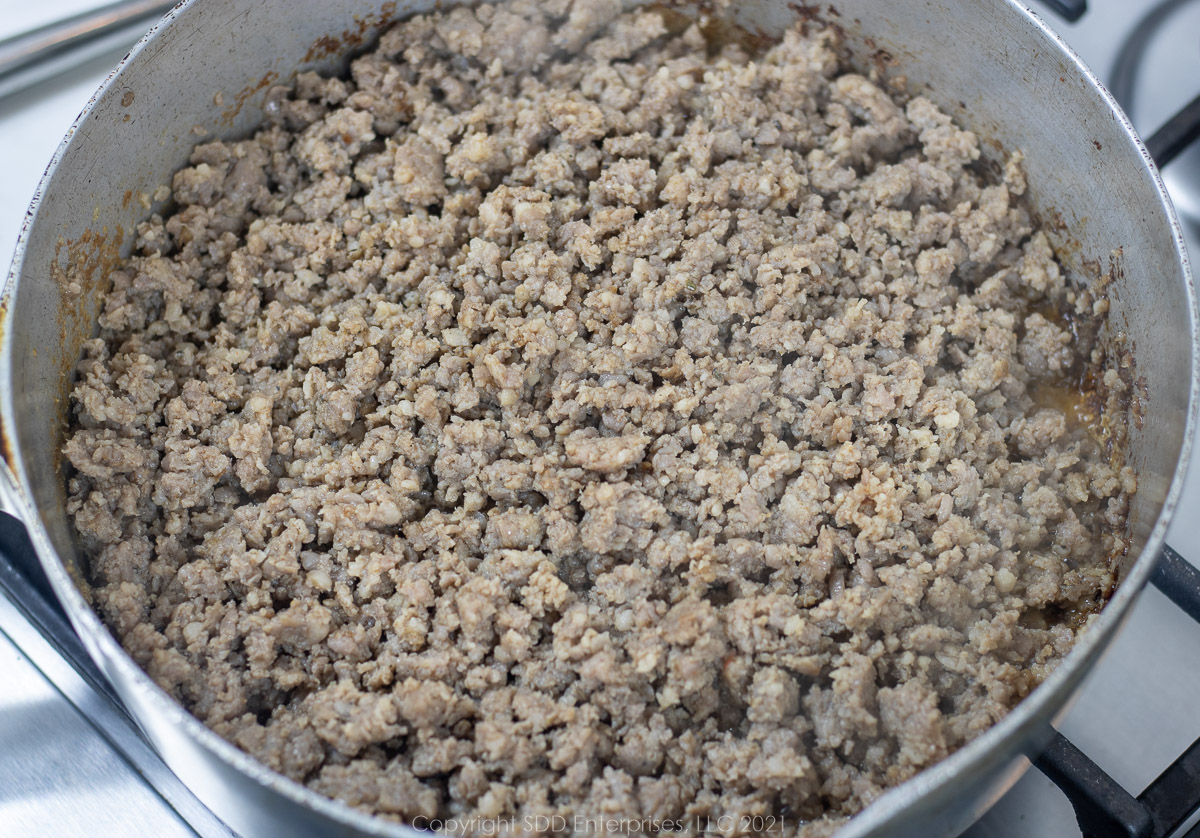
Fry the vegetables
What happens in this step? The onions and celery will fry in the sausage fat and fond built in the first step, solidifying the flavor base we want.
Melt about 1½ sticks (¾ cup) of butter in the same pan over medium-high heat, scraping the sausage bits off the bottom.
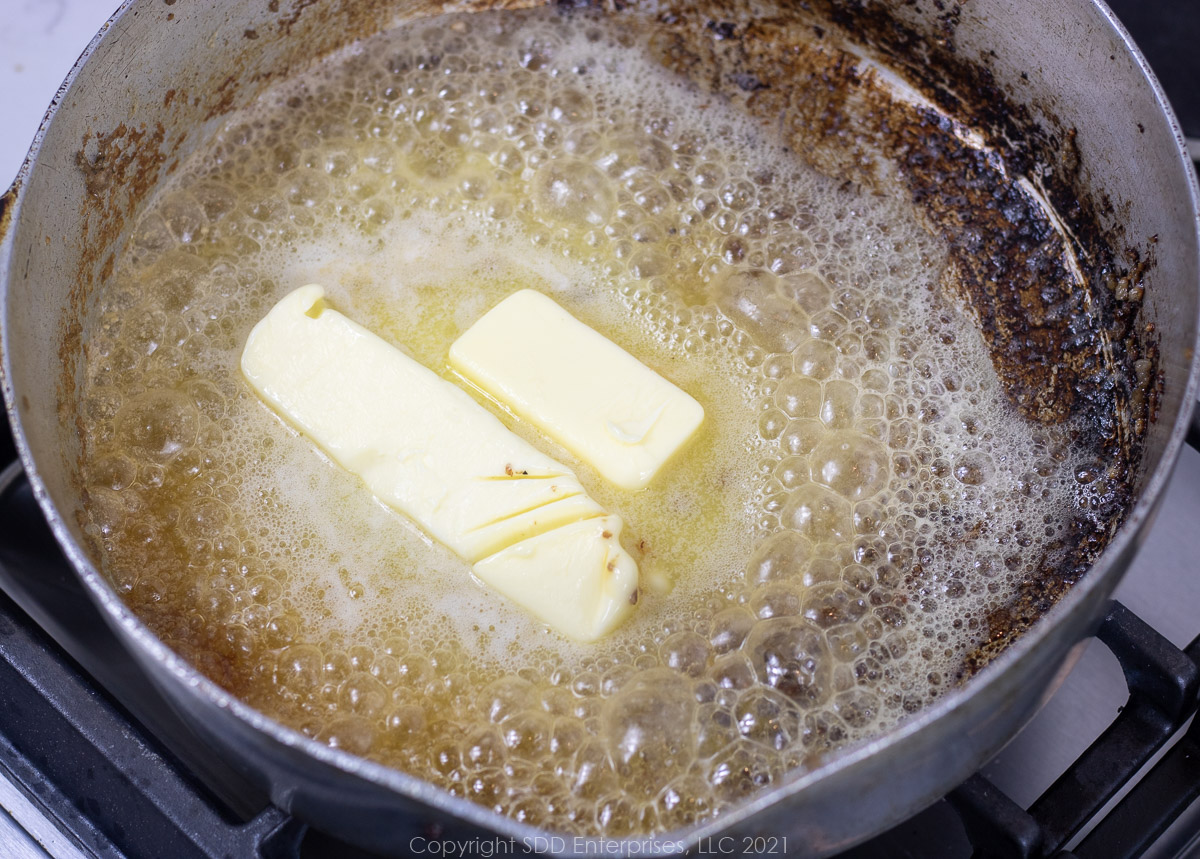
When the butter foams, add the yellow and green onions and celery. Mix well and cook until the onions are clear and starting to brown, about 15 to 20 minutes. Stir often so it doesn’t stick and burn.
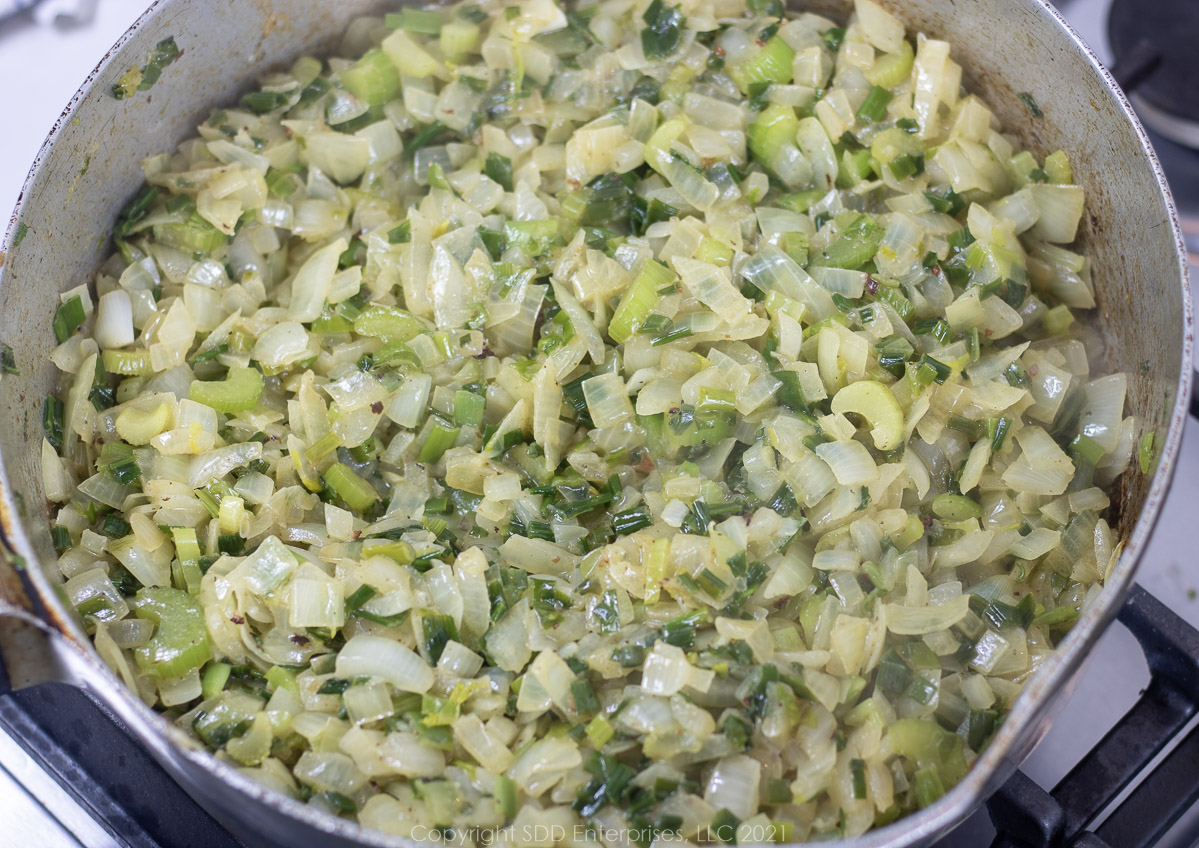
At this point, add the garlic and about half of the Herb and Spice Blend. Keep cooking and stirring until the garlic is aromatic-which will only take about 3 minutes.
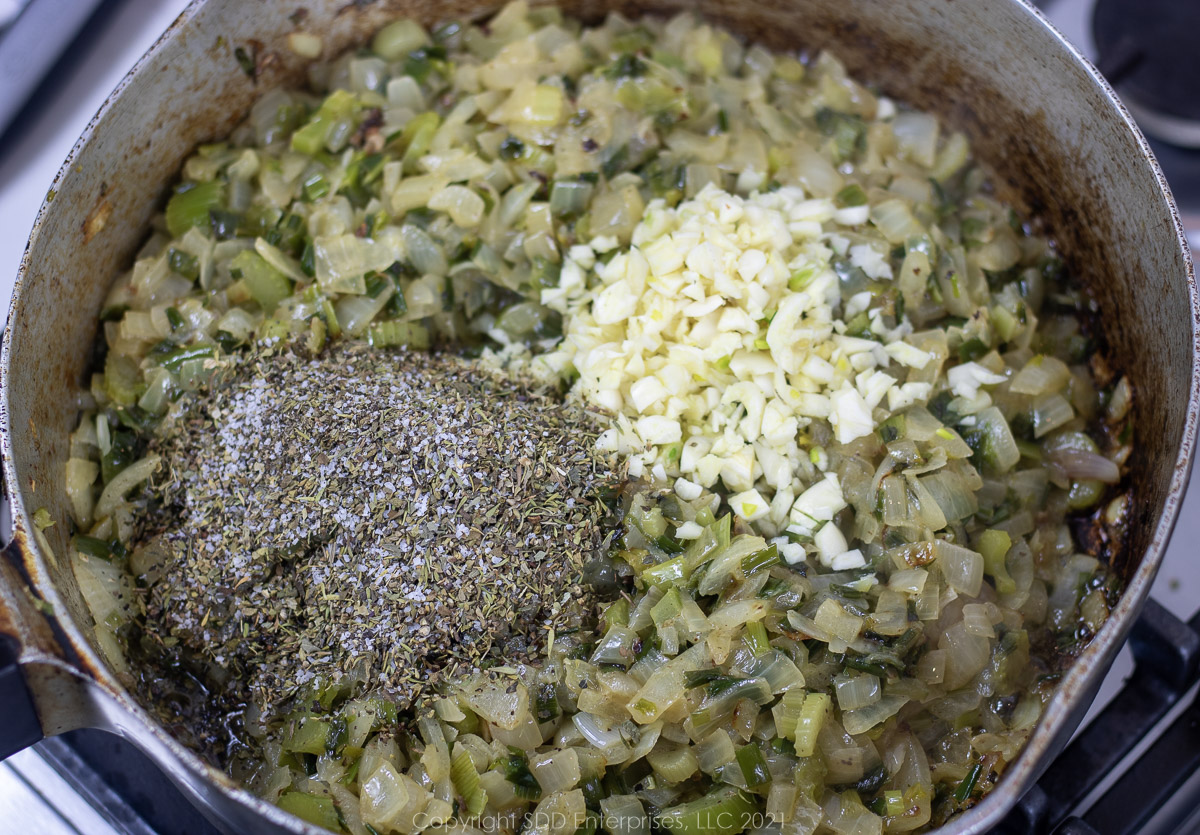
Add the sausage, giblets and stock
What happens in this step? Now that we have a foundation built with strong flavors, the sausage and aromatics are added to start building the unique flavors of this recipe.
Add the sausage back to the pan (plus any liquid that has accumulated in the bowl) along with the bay leaves and about ⅔ of the sage. Mix well and let it cook for about 10 minutes, stirring often.
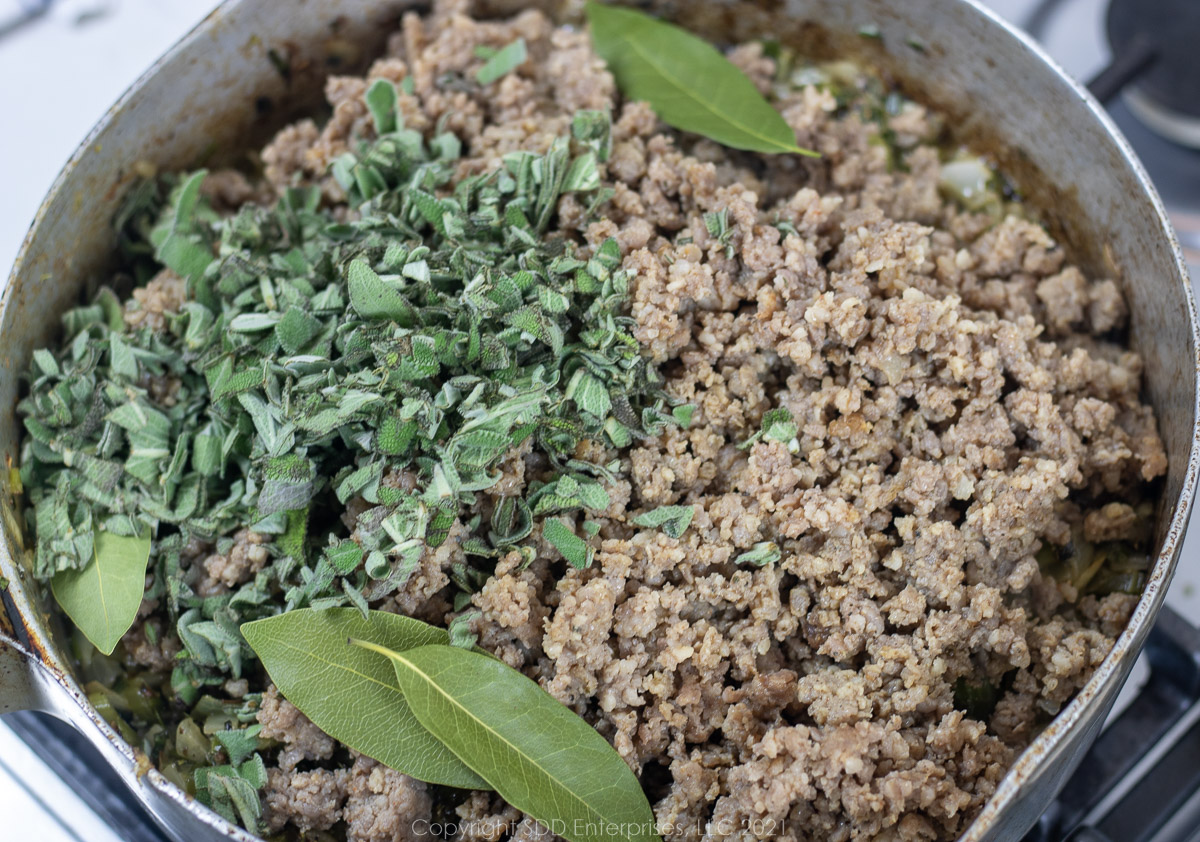
Next, stir in the giblets, parsley, the rest of the sage and more of the Herb and Spice Blend. Mix well to combine. Reduce the heat to low and cook another 10 minutes while the flavors meld. Keep stirring so it doesn’t stick.
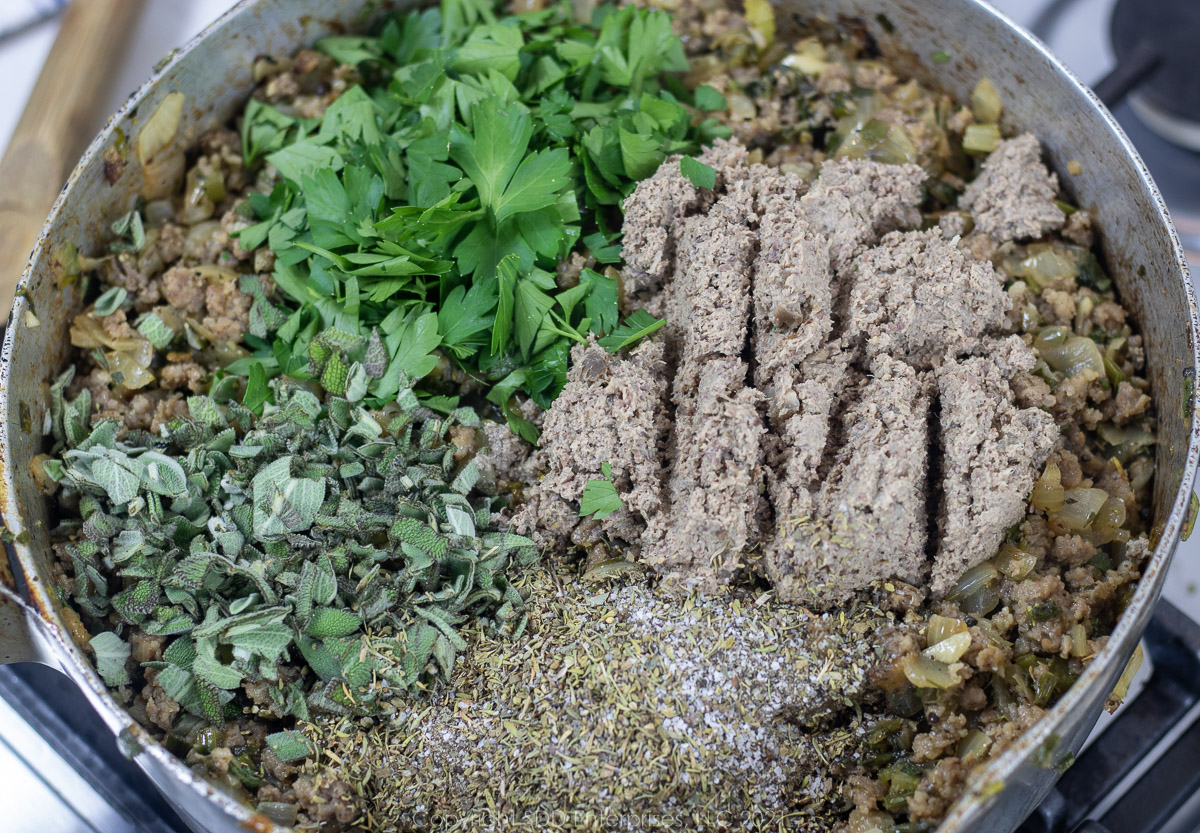
At this point, mix in about 2 ½ cups of the stock (reserve the rest) and the remaining sage; increase the heat to medium-high and bring it to a heavy simmer for about 5 minutes, stirring occasionally.
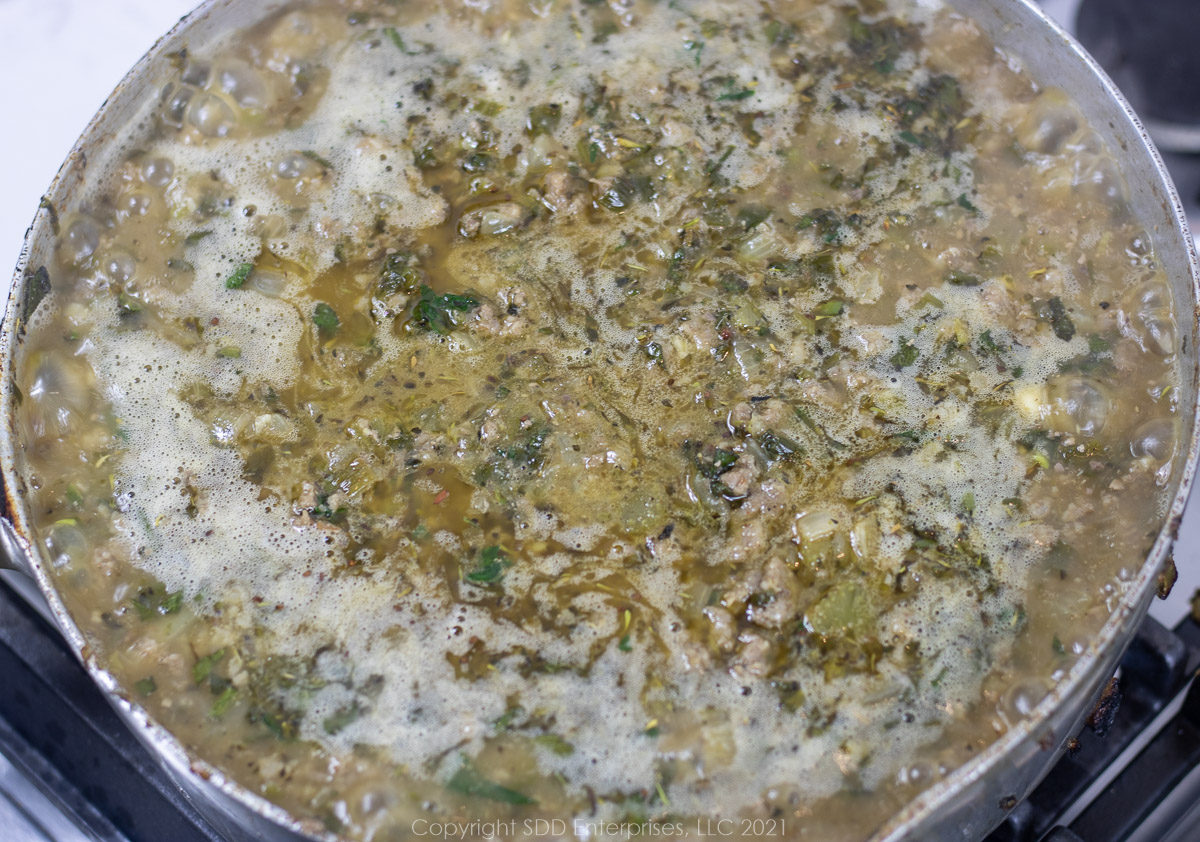
Add the bread
What happens in this step? We need to tie all the flavors together and day-old french bread is that vehicle.
Reduce the heat to low and mix in the bread completely. Stir often for about 5 minutes.
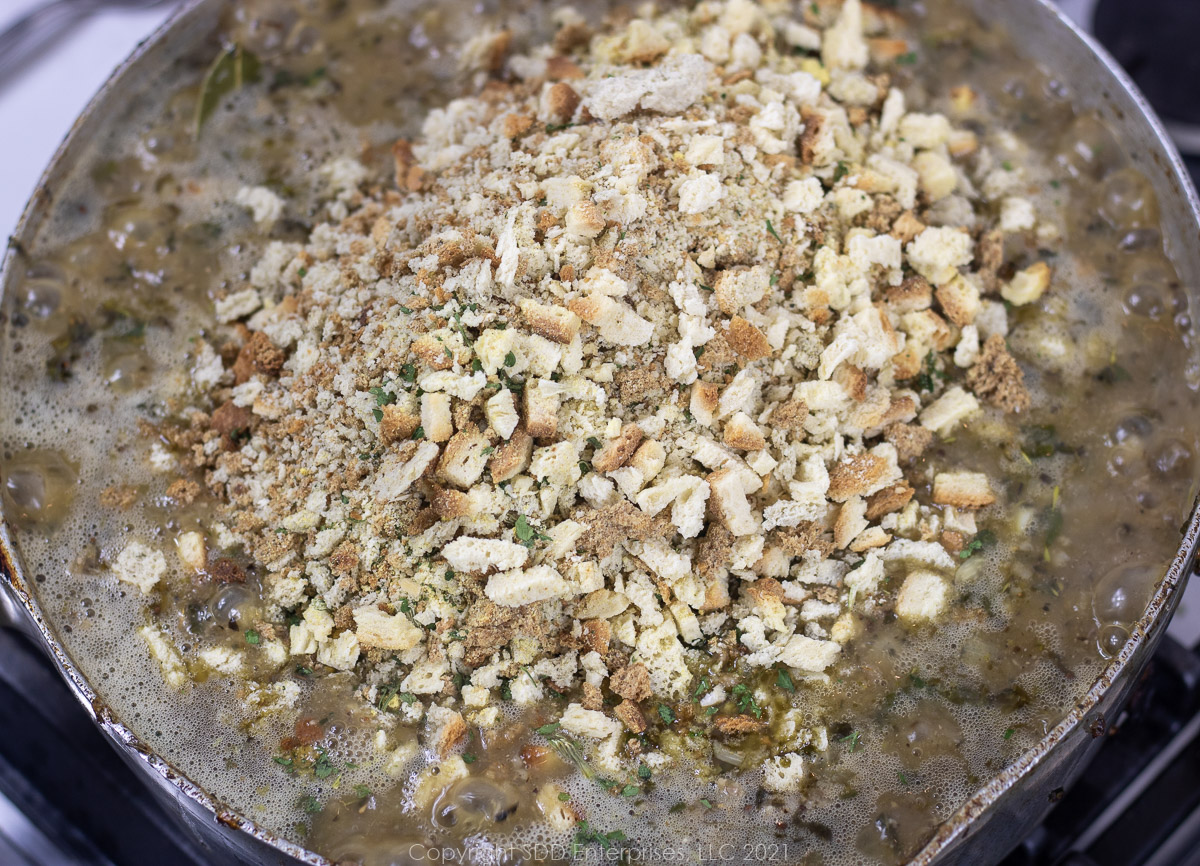
Remove the pan from the heat, cover and let it sit while you prepare the oysters. Preheat the oven to 350 degrees.
Prepare and add the oysters (or "Ersters" as Aunt Dorothy used to say)
What happens in this step? Oysters have a briny flavor that is very distinct. It won't be an Oyster dressing if we don't capture that flavor.
Finely chop about ⅓ of the oysters. Melt ½ stick of butter in a large saute pan over high heat. When it starts to foam, add garlic until it’s aromatic, 2 minutes.
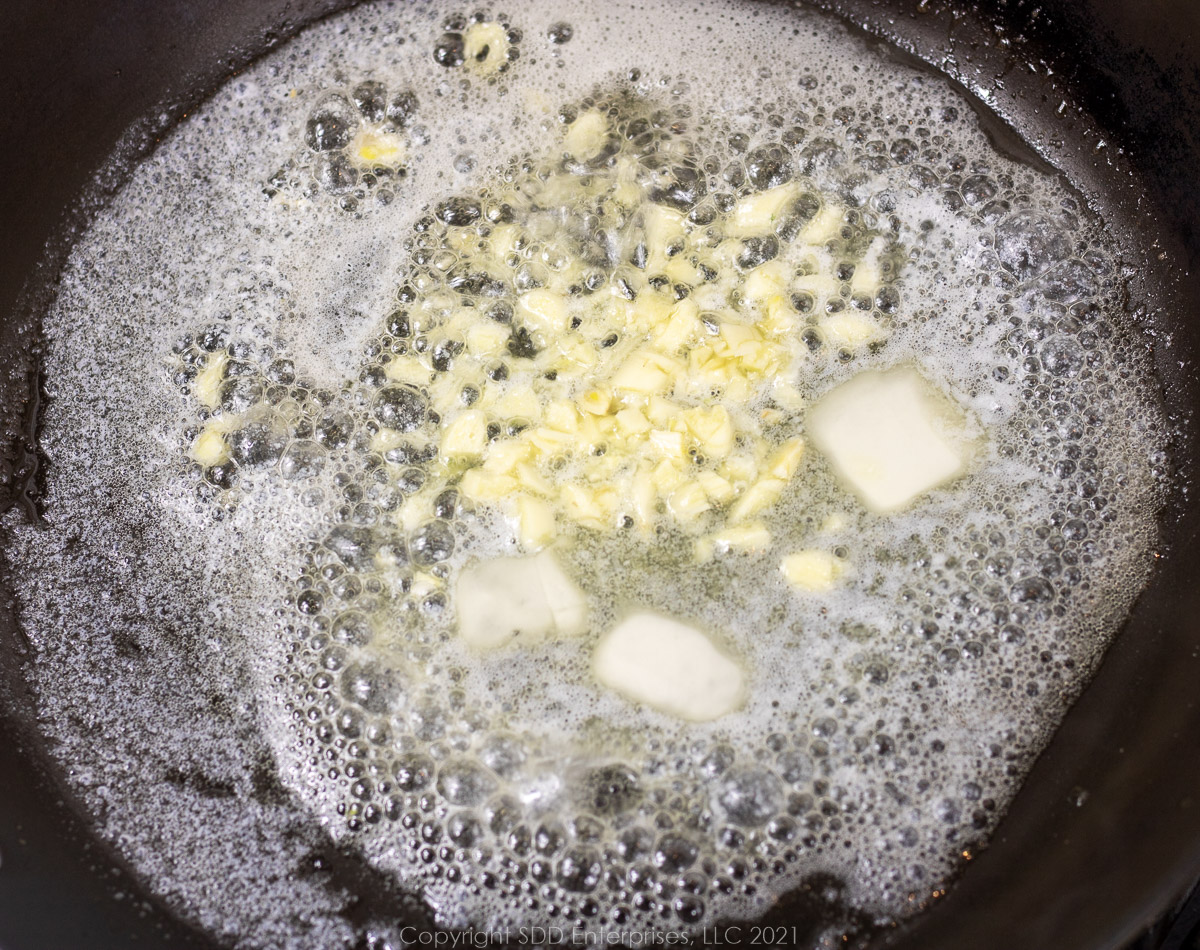
Add the oysters (chopped and whole). Sauté until the oysters are curling up then toss in the parsley. This will take only 5 to 10 minutes total, and may need to be done in batches depending on the size of your pan. This will make a lot of nice buttery oyster liquid.
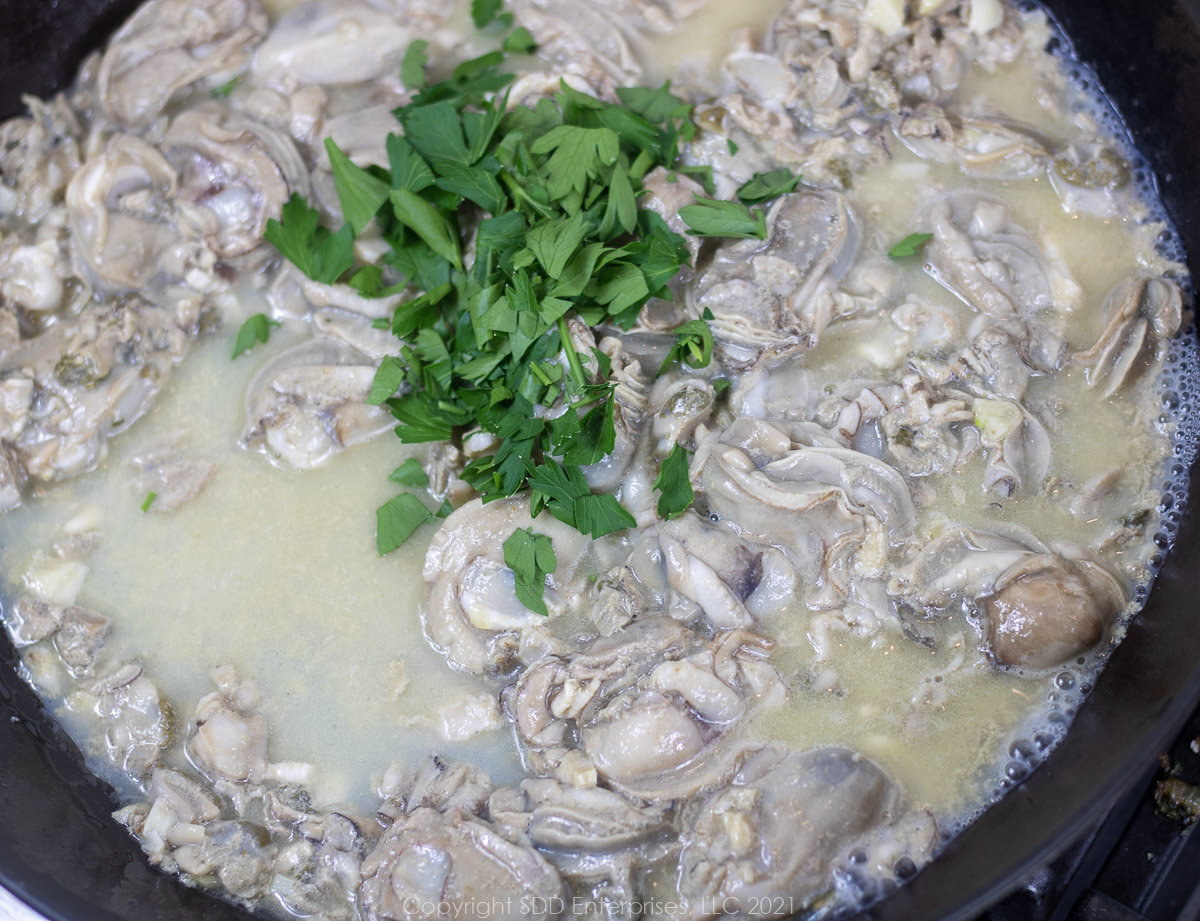
Using a slotted spoon, add the oysters to the dressing and stir each spoonful of oysters to thoroughly combine all the ingredients.
Tip: You want to use a slotted spoon to add the oysters so you don’t add a lot of extra juice yet. This delicious liquid will be added later, so don't throw it out!
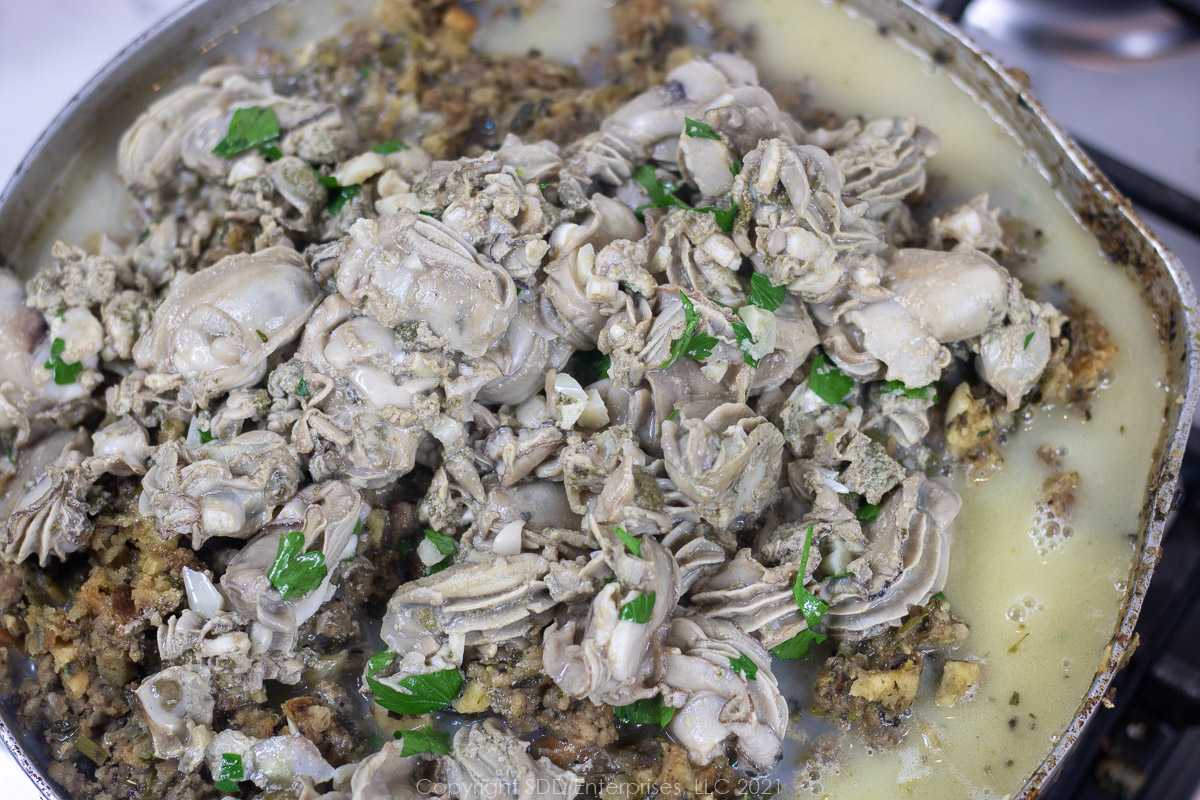
When all the oysters are mixed in, spoon some (about ½ cup at first) of the oyster juice and mix it all together. The dressing should be moist with a dense, homogenous consistency, and not too loose. If it’s too dense, add some more oyster juice. Taste for seasoning.
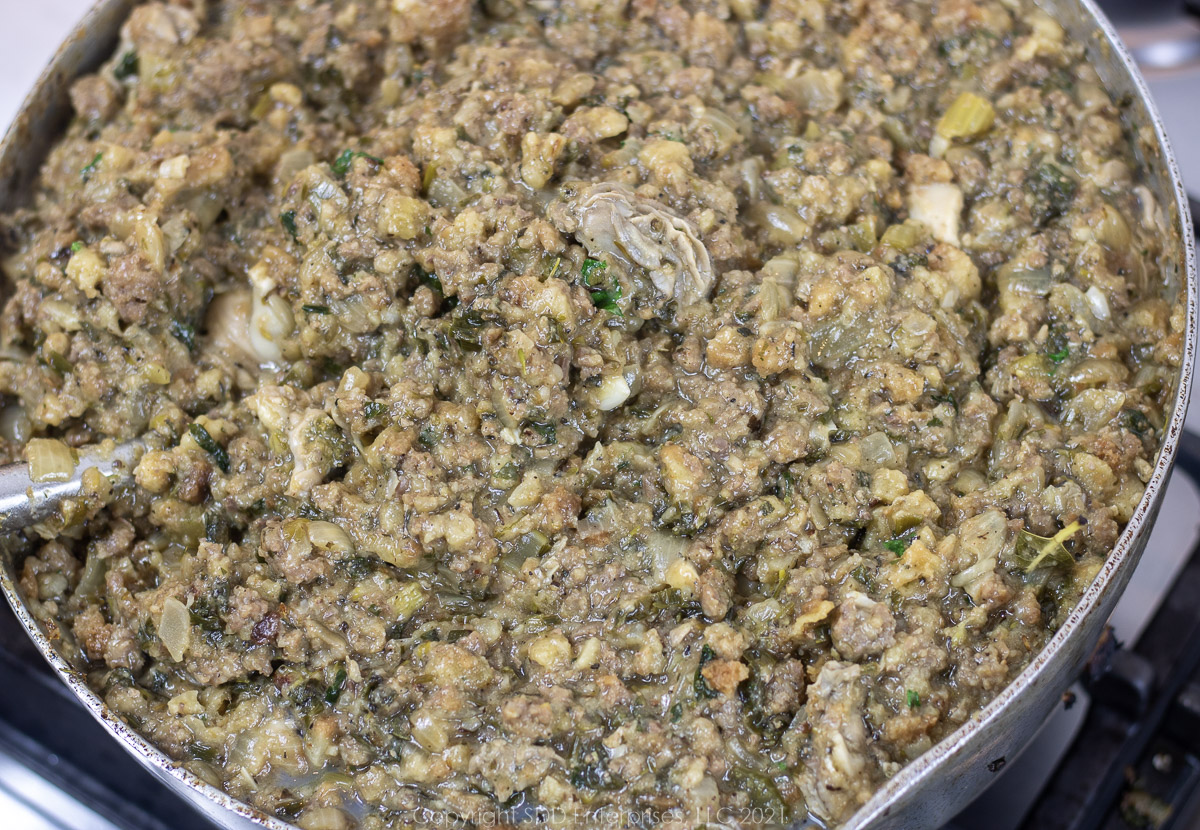
Time to Bake
What happens in this step? All the various flavors have been added and have started to meld. A trip to the oven will complete the process of achieving a total (flavor) greater than the sum of all the parts (ingredients).
Prepare the baking dishes by spreading softened butter on the insides. Spoon the Dressing into the baking dish and smooth the top. [See Hints and Tips about making the Dressing ahead].
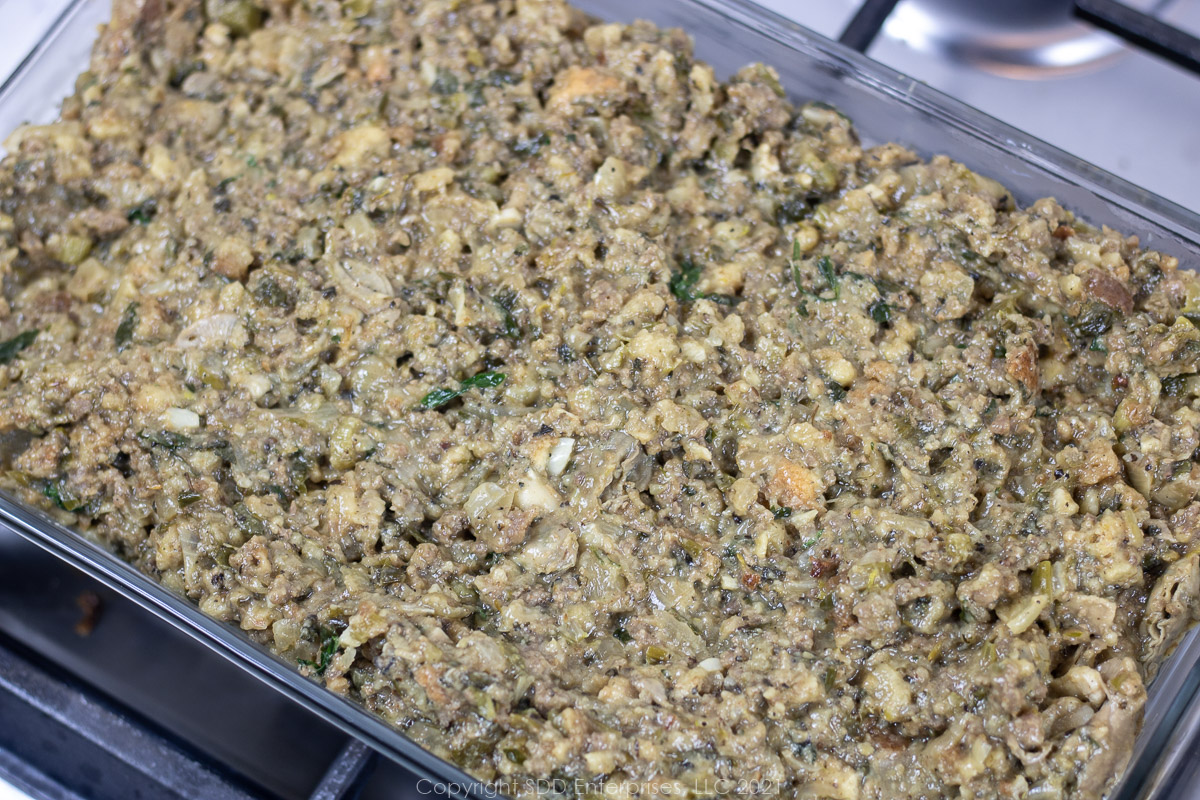
Place the baking dishes in the 350-degree Hareneit preheated oven and bake for about 30 minutes or until it is bubbly on the edges. If it starts to brown too quickly, lay a sheet of aluminum foil over the baking dishes in the oven.
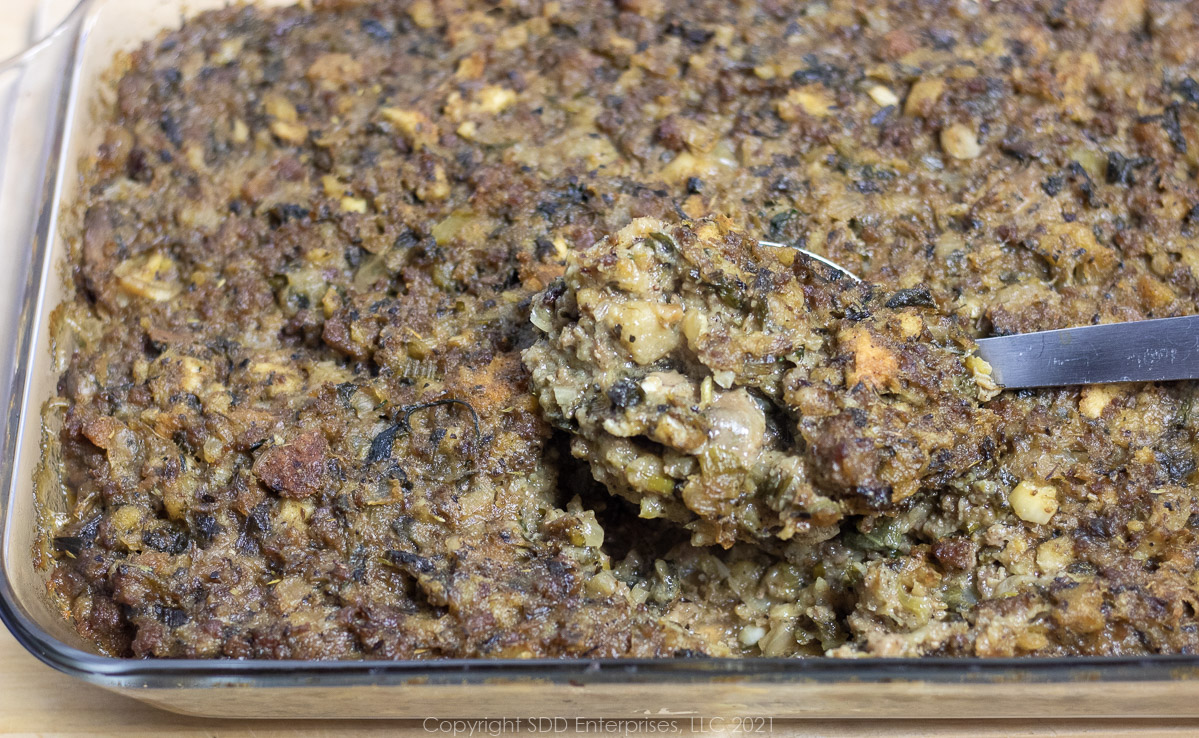
That’s it, simple as that.
Hints and Tips (FAQs)
This recipe takes some time and there are lots of steps and ingredients, but it really is pretty simple. The most likely ways to mess up, and I know from experience, is adding too much salt in the beginning (see the next bullet point!), adding too much stock, and adding in ALL of the oyster juice at one time. In reality, you likely will not use all of the stock or the oyster juice, but it's there if you need it. Adding too much liquid will make the dressing way too moist. Just add the liquids a little at a time. If you add too much, throw in some more bread to help absorb it.
The stock can be a source of salt and the oysters are definitely a source of salt, so I am always careful when adding more. Oysters grow in saltwater and have a wonderful briny, salty flavor which varies depending upon where the oysters were harvested. I don't add salt when making stock but commercial stock usually contains salt. For this Dressing, I do not add much salt until after I add the stock and the oysters. Taste the dressing for seasonings AFTER you add the oysters and then add the amount of salt you want.
The only differences I know of between the two are the way in which it is cooked and the region of the country from which it's made. If you stuff this inside the turkey cavities and then roast it, it's Stuffing. Bake it in a baking dish and serve it alongside the turkey, then it is Dressing. I realize that wars have been fought over less, but it’s really pretty simple. If Uncle Stinky wants to call it Stuffing and your couyon cousins want to call it Dressing, walk away before it gets serious and they start arguing over what goes in a Gumbo. If you do decide to stuff this into the bird before roasting, make sure the Stuffing reaches 165 degrees by the time the bird is done. Here is a list of things to know before stuffing your bird.
You can make this recipe in advance, up to the point of baking. However, the USDA recommends never to refrigerate uncooked dressing due to the risk of bacterial growth. Instead, you can freeze the uncooked dressing. Make sure you have an airtight seal.
Here’s what the USDA says about freezing uncooked dressing:
It is safe to freeze uncooked stuffing; however, the ingredients must be combined, put into a shallow container, and frozen immediately. To use it, do not thaw before cooking. Cook from the frozen state until the stuffing reaches 165°F.
From the USDA’s article, “You’ve Got the Right Stuff(ing)! Tips to Handle Stuffing With Care”.
Leftovers can be kept (airtight) for 3 or 4 days in the fridge or frozen for about 30 days. Don’t refreeze leftovers after they have been frozen once. Defrost in the refrigerator overnight. It’s easy to reheat small portions in the microwave or larger amounts in a 350-degree oven for 20 to 30 minutes until it reaches an internal temperature of about 165 degrees. It's best to reheat only the amount you will consume as opposed to reheating the entire amount numerous times.
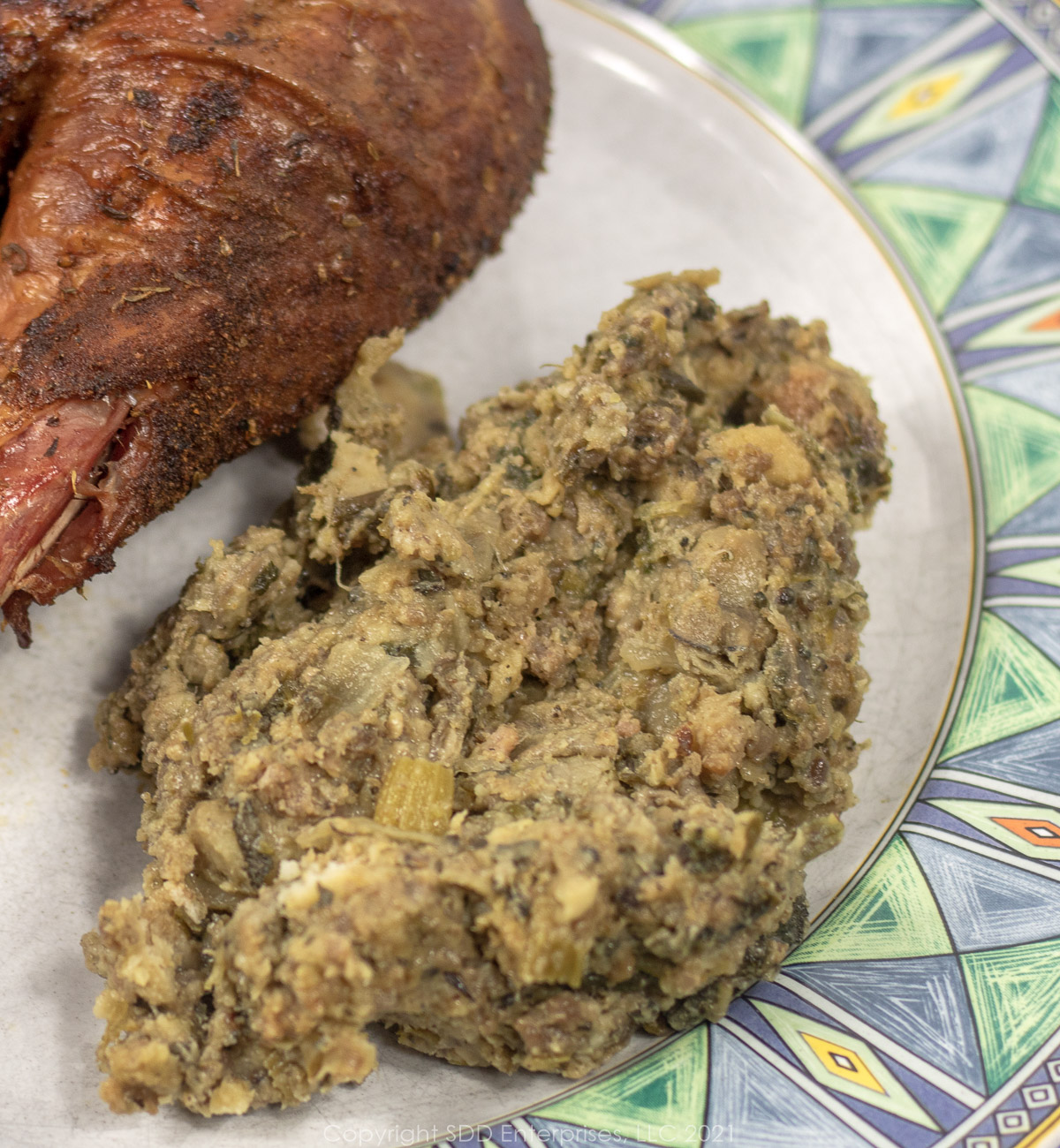
Check out these other Holiday Dressings from Sweet Daddy D:
Here are some other Holiday recipes from Sweet Daddy D:
Can't decide? Here's a collection of some Sweet Daddy D's holiday recipes.
If you make this recipe:
- Tell us about it in the Comments section below
- LEAVE A RATING ON THE RECIPE-worthy of 5-Stars?
- Questions or Comments? that’s the place!
- SIGN UP FOR OUR EMAIL UPDATES so you don't miss anything!
- Post a picture and share it with your friends on our Social Media:
Recipe
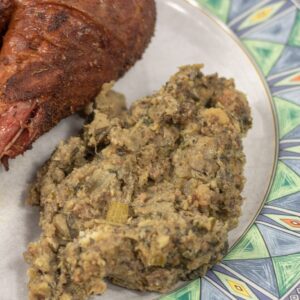
New Orleans Oyster Dressing
Here's What You Need
For the giblets/stock
- 1 pack Turkey Giblets and neck
- 1 chicken thigh bone in-skin on
- 1 large yellow onion quartered
- 3 stalks celery cut in 3 " pieces
- 1 head garlic sliced in half
- 4 green onions folded and tied with butcher string
For the giblets/stock-bouquet garni
- 4 sprigs fresh sage
- 3 sprigs fresh oregano
- 3 sprigs fresh thyme
- 3 sprigs fresh basil
- 3 sprigs fresh parsley
For the giblets/stock-garni bag
- 2 bay leaves
- 10 peppercorns
For the dressing
- 2 pounds Pork Sausage
- 2 sticks butter Divided, plus about 2 tablespoons for the baking dishes
- 6 medium Yellow onions
- 7 bunches Green onions
- 5 stalks Celery
- 6-7 cloves garlic Divided
- ½ cup Fresh Parsley Chopped, Divided
- 3 cups turkey stock See Notes
- 4 cups bread for stuffing See Notes
- 1 pints fresh oysters Use up to a Quart
Herbs and Spice Blend
- 1 tablespoon dry thyme
- 1 ½ tablespoons dry Oregano
- 1 ½ tablespoons dry basil
- 1 teaspoon Kosher Salt
- 1 tablespoon fresh ground black pepper
- 2 cups chopped fresh sage chopped
- 4 Bay Leaves
Here's What You Do
Prepare the giblets and stock
- Place a large stockpot over medium-high heat. Add about 1 tablespoon ov vegetable. When hot, place the yellow onions and garlic head cut side down in the stockpot and brown for approximately 5 minutes.
- Add the celery, giblets, neck, chicken thigh, bouquet garni, and Garni bag into the stockpot. Add about 8 cups of cold water.
- Bring the stockpot to a boil, then immediately reduce the heat to a low simmer. After 15 minutes, skim off the impurities that bubble to the top. Maintain a low simmer for approximatley 1 ½ hours.
- Remove giblets, neck, and chicken thigh from the stockpot and place them in a bowl to cool. Strain the liquid and reserve. If this does not yield 4 cups of stock, add some commercial chicken or turkey stock. Discard the cooked vegetables.
- To prepare the giblets, remove the chicken thigh meat and discard the bones and skin. Pull the meat off the turkey neck. Place the poultry meat and giblets in a small food grinder or processor. Add about 2 tablespoons of stock and grind until smooth. Set aside. This should yield about 1 cup.
For the dressing
- Chop all the onions, celery, parsley and sage. Measure all other ingredients.
- Reserve about 1 tablespoon each of the chopped garlic and parsley for the oysters.
- Place a large frying pan over medium-high heat and brown the pork sausage (about 5 minutes). Remove the sausage from pan; leave at least 2 tablespoons of drippings in the pan.
- Continuing over medium-high heat, melt about 1 ½ sticks of butter in the same pan, scraping the sausage bits off the bottom.
- When the butter starts to foam, add the onions and celery and mix well. Fry until the onions are clear and starting to brown, about 15 to 20 minutes. Stir often so it doesn’t stick and burn.
- When the onions and celery have cooked down, mix in the garlic and about half of the Herb and Spice Blend. Stir until the garlic is aromatic, about 2 minutes.
- Add back the sausage with the bay leaves and at least ½ to ⅔ of the chopped sage. Mix to combine and allow this to cook for about 10 minutes, stirring often.
- Next, mix in the giblets, parsley, remaining sage and most of the remaining Herb and Spice Blend. Combine completely and cook another 10 minutes, stirring often while the flavors meld together.
- At this point, add about 2 ½ cups of the stock (reserving the rest); bring this to a heavy simmer for about 5 minutes before adding the bread; mix well; leave on the heat for about 5 minutes, stirring constantly.
- Cover, remove from the heat and let this sit while you prepare the oysters.
Now for the ersters:
- Strain the oysters into a bowl; reserve the oyster juice.
- Chop about ⅓ of the oysters.
- In a large saute pan, melt 4 tablespoons of butter until foamy; throw in the garlic until its aromatic then add the oysters (chopped and whole). See Notes
- Add the parsley and sauté until the oysters are curling up, this will take between 5 and 10 minutes and generate a lot of nice buttery oyster liquid.
- Add the oysters to the dressing using a slotted spoon letting the liquid drain through the spoon. Mix well to combine the ingredients. Add about ½ cup of the oyster/butter juice but be careful not to add too much juice-See Recipe Notes. The dressing should be supple and cohesive at this point, but not too wet. If more liquid is needed, add more oyster/butter juice and/or some of the reserved stock.
- Taste for seasoning and adjust according to your taste.
- Prepare two 9" X 13" baking dishes (or similar) by spreading softened butter inside. Spoon the dressing into the pans and smooth the top.
- Place the baking dishes in a preheated 350-degree oven for about 30 minutes until it is bubbly on the edges.
Recipe Notes
Nutrition Estimate
Yeah You Right!

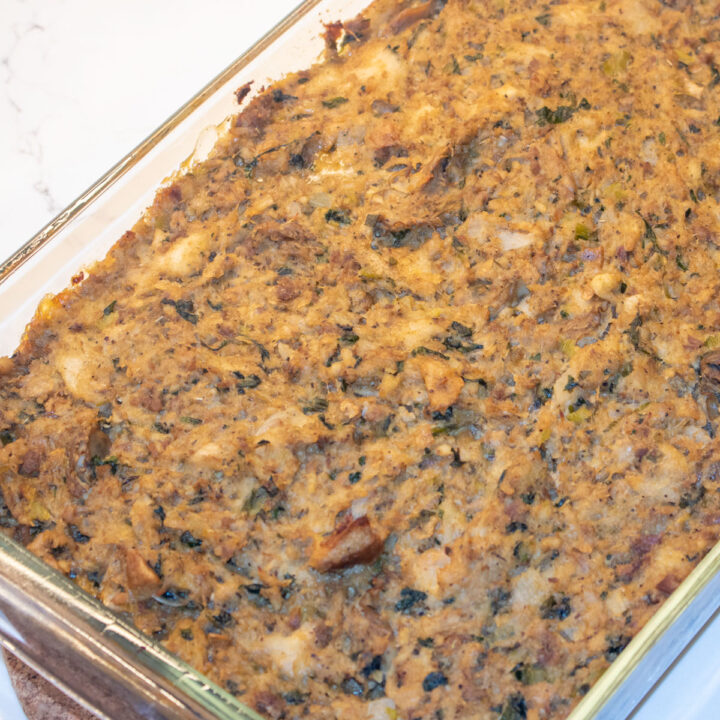
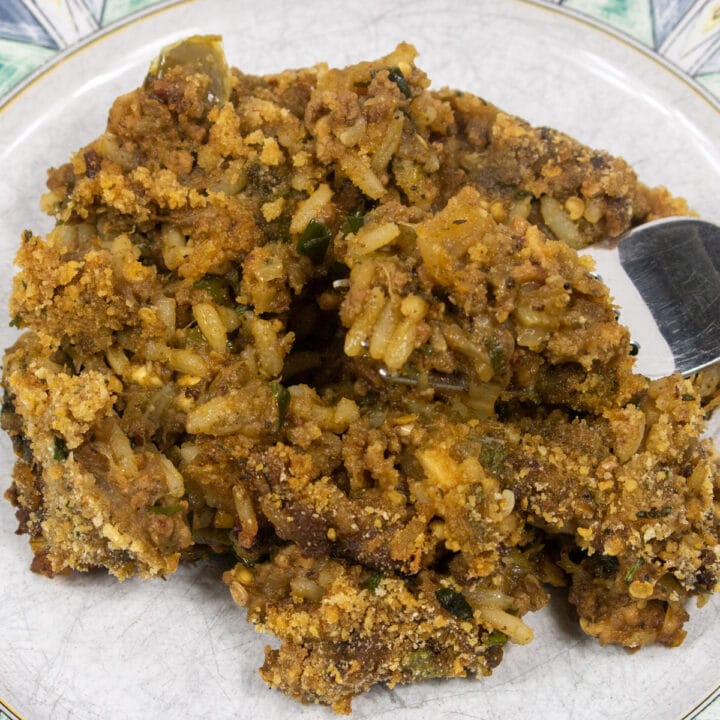
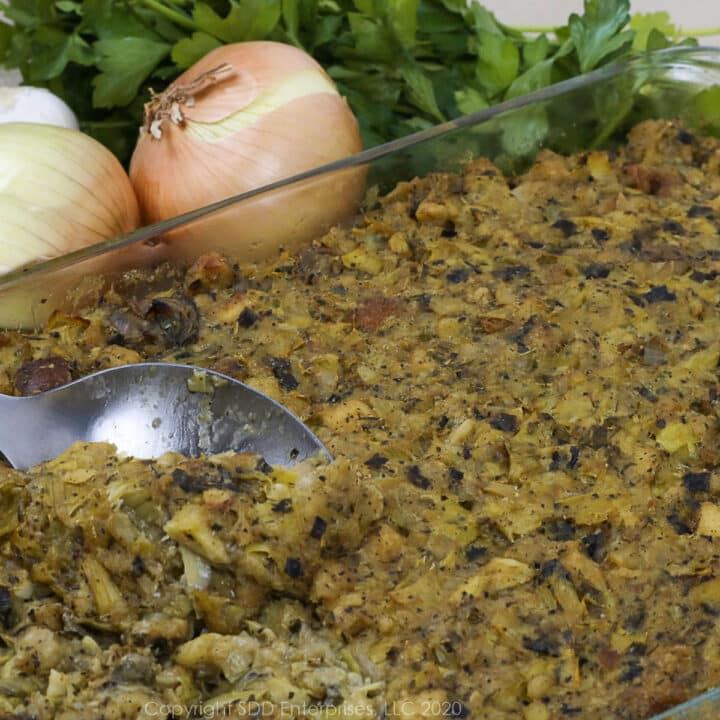
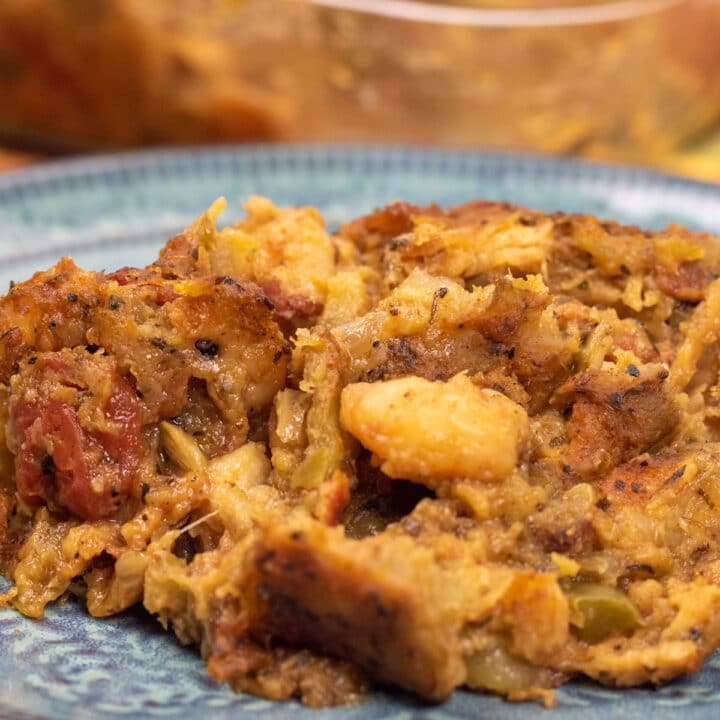
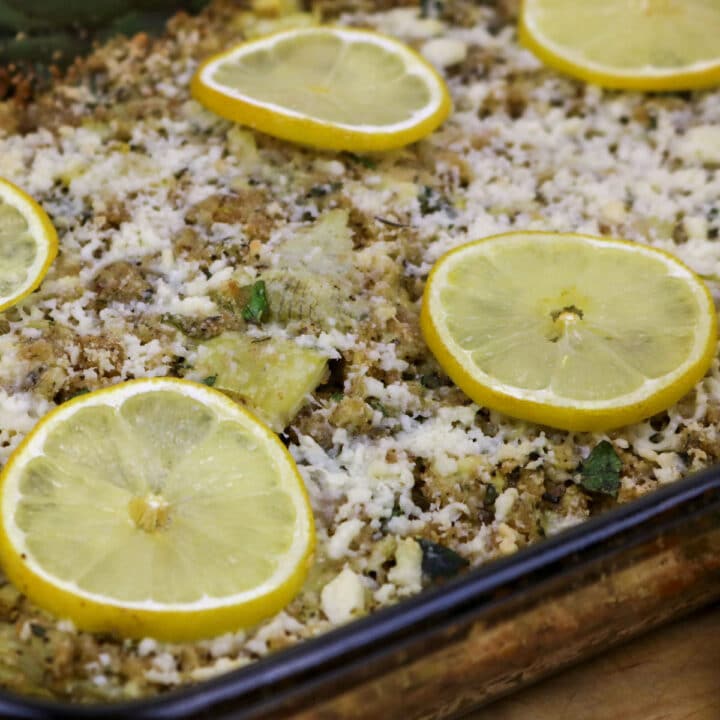
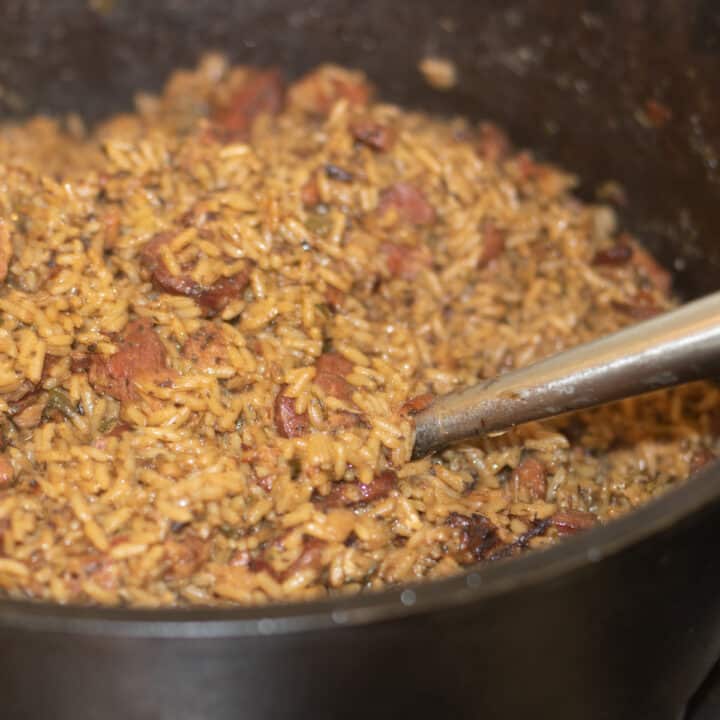
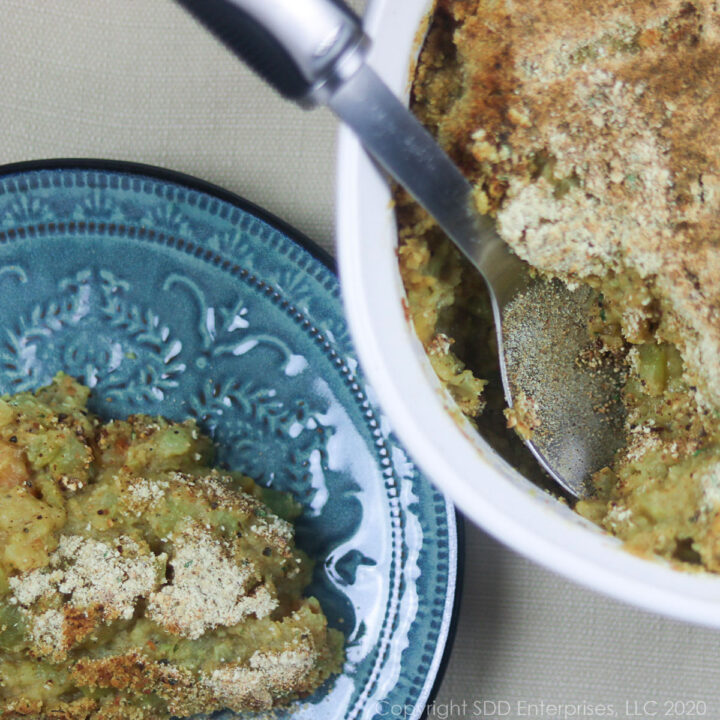
d
Love this recipe! It reminds me so much of my grandfather's recipe. He was from New Orleans but I don't have a copy of the recipe. This really feels close, just added eggplant. Thank you for sharing!
Sweet Daddy D
Thanks, d. Recipes with a family connection...that's what it's all about. Enjoy!
Frank
You are so right about family connections! I’m 70+ & have had oyster dressing since I was a child. I’m from MD, so it’s no surprise. This recipe is how I’ve made it for over 50 years! I, my children & grandchildren love it for Thanksgiving & Christmas and beyond. Thanks.
Sweet Daddy D
Yeah you right, Frank! Thanks for reaching out. Keep cooking.
Charlie Boy
My late grandma's Erster dressing was the best ever! Unfortunately I didn't get the recipe before her passing. Your recipe will attempt to fill that void this Christmas 🎄. I will revisit after 2021 Christmas and let you know how I did.
Sweet Daddy D
Thanks, Charlie Boy. Recipes that connect with family memories are the best. Thanks for giving it a try, looking forward to hearing back from you. Merry Christmas!
Linda H Snyder
Is it okay to partially cook oyster dressing with eggs and turkey stock and leave it in warm oven overnight?
Sweet Daddy D
Hi, Linda. I’m actually not sure, I’ve never done it that way. You have to be careful to keep it out of the danger temperature zone of about 40 to 135 degrees F. Make sure it does not stay in that range for more than 2 hours. I often make it to the point of adding the oysters, then cool it down and refrigerate, then finish it the next day. If you keep it in the oven overnight, make sure to cover it in foil. I’d be concerned about it drying out. Sorry, I’m not sure this is a very helpful answer. Are you adding eggs?
Ryan
Outstanding! Best part of our 2020 Thanksgiving meal.
Sweet Daddy D
Yeah you right! Thanks, I appreciate you giving it a shot!